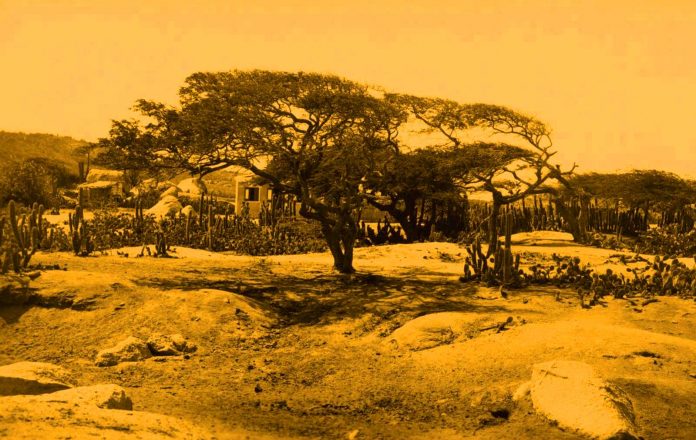Etnia Nativa facilitates cultural awareness, education and safeguards Aruba’s heritage by elevating each reader into an island keeper state of mind. Be encouraged to discover in every episode the true native effect, live it, get more reasons to love Aruba behind the beaches and liven up your stay in an incredibly wonderful way.
The watapana is a tree that often appears adorning the entrance of a typical Aruban houses.
Watapana-(Caesalpinia coriaria) erroneously called “Divi’divi” (to see episode 126) is a crooked small tree, growing to a height of 10 meters in good conditions, in this episode we will have it about some of alternatives uses of this very well know Aruban tree, logo of public TV station, native to Tropical America and the West Indies.
Watapana is propagated by seed. During the first two years, watering is necessary specialy during the dry season. Mature trees require very little care, and forage crops can be planted between the trees. Trees are relatively slow growing and generally commence flowering 5–7 years after sowing. Full crops of pods are produced after about 20 years. Some fungi varieties such as Fomes lucidus, Micropeltis domingensis and Zignoella caesalpiniae, attacks these pod known also by the name divi-divi: These divi-divi pods are collected before or after they drop from the tree. Trees yield about 45–135 kg pods per year.
The pods of Caesalpinia coriaria are very rich in tannin and are used in the tanning industry. The tannins can easily be extracted.They are mainly present in the white powdery tissue just below the epidermis of the pod, and this tissue is easily collected when the dry pods are ruptured.The tan stuff from the pods is generally used as a blend for tanning leather, mixed with other tanning materials. Divi-divi is often used in rapid drum tanning of light leathers and in leather dressing. The pods are also used to prepare a blackish or bluish dye for cotton and wool and a black ink, used e.g. in the decoration of traditional potteries and gourds in Central America. They are sometimes employed as a mordant for dyeing vegetable fibres with other dyes.
Certain places in India use watapana wood as a source of red dye.
In addition, studies carried out ensure that watapana has certain medicinal properties: Like containing antibacterial alkalines, corrosion-inhibiting, anthelmintic, anticancer, antihelminthic, and antidiabetic.
Other studies also indicate that Caesalpinia coriaria is a potential candidate plant for the management of phytopathogens, which are fungi that affect plants such as rice, wheat, corn, potatoes and soybeans, which are very important worldwide. The antibacterial active extract of its leaves and pods are verey actively in combating the first invasive signs. Is very important.
Research done in countries like Mexico showed that pods are used to bandage sores because they have a rapid anti-scar and anti-inflammatory effect.
If you love Aruba its origins and its cultural heritage, be part of the exclusive visitors of Etnia Nativa: a cozy museum/home.
Etnia Nativa a private residential houses collections of native art, archaeological artifacts and historic furniture, while the facilities themselves are the result of the transformation of recycled materials. Meet Anthony Croes, our columnist at his home! Book your visit Whatsapp + 297 592 2702- or mail: etnianativa03@gmail.com




















